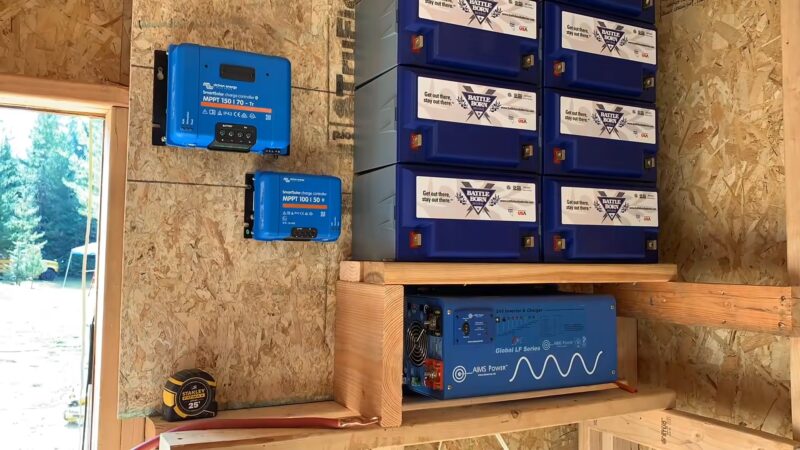Embarking on your “off-grid” journey can be an exciting adventure, filled with the promise of self-sufficiency and a closer connection to nature. However, like any new endeavor, it’s bound to come with its fair share of learning curves and initial hiccups. One of the most common areas where beginners face challenges is managing their energy systems, particularly their battery banks.
If you’re just starting out, it’s crucial to understand that your initial foray into off-grid living might be a bit rough on your batteries. Even if you opt for the most expensive, top-of-the-line models, they’re likely to bear the brunt of your early mistakes.
Beware of solar installers or designers who try to sell you an ultra-premium, and correspondingly pricey, battery bank for your first energy system. This could be a sign that they lack experience or are more interested in their profit margins than in providing the best solution for you. It’s a painful truth that spending $10,000 to $20,000 (or more) on a battery bank that doesn’t last half as long as it’s supposed to is not a wise investment.
The reality is, most beginners will make mistakes that can shorten the lifespan of their first set of batteries. But don’t worry, this is a normal part of the learning process. Once you’ve navigated these initial challenges, you’ll be better equipped to invest in a higher-quality battery bank.
In this article, we’ll explore the best battery bank options for those new to off-grid living. We’ll guide you through some excellent choices that offer a balance of quality and cost-effectiveness, perfect for beginners. These include:
- Trojan T105 Golf Cart 6 Volt 225 AH
- Trojan L16 6 Volt 370 AH
- Surrette S460 6 Volt 350 AH
- Surrette S530 6 Volt 400 AH
Let’s dive in and find the right battery bank for your off-grid adventure.
Trojan T105s 225 Amp Hours at 6 Volts
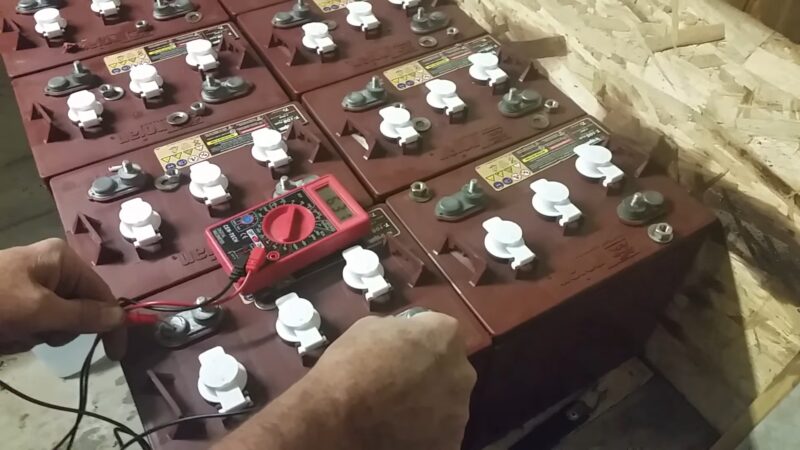
The T105s are the cheapest but they might not be the best choice for larger systems due to the need to parallel many batteries together to get the required amp hours. What is wrong with paralleling multiple battery strings together?
Trojan’s T105s have a C20 rating of 225 AH (amp hours) at 6 volts. The usual price for a Trojan T105 is approximately $80-120 USD each. The price is closer to $80 when buying in bulk.
The T105s are a good balance between cost and performance. They were originally made for golf carts but have gained a lot of traction in the solar industry.
Here Are the Numbers for the Trojan T105 if You Were to Install One String in Your Battery Bank:
225 amp hours at 12 volts – providing 3.3 kWh at 100% discharge – 2 batteries in total
225 amp hours at 24 volts – providing 6.6 kWh at 100% discharge – 4 batteries in total
225 amp hours at 48 volts – providing 13.2 kWh at 100% discharge – 8 batteries in total
Here Are the Numbers for the Trojan T105 if You Were to Install Two Strings in Your Battery Bank:
550 amp hours at 12 volts – providing 6.6 kWh at 100% discharge – 4 batteries in total
550 amp hours at 24 volts – providing 13.2 kWh at 100% discharge – 8 batteries in total
550 amp hours at 48 volts – providing 26.4 kWh at 100% discharge – 16 batteries in total
A new set of T105s should last 4-6 years if looked after (according to what is taught in this article) in a well-designed solar electric system. We have used them for up to 8 years before replacing them, although the last few months were not great. If abused and treated poorly, they will last about 1-2 years.
Trojan L16s 370 Amp Hours at 6 Volt
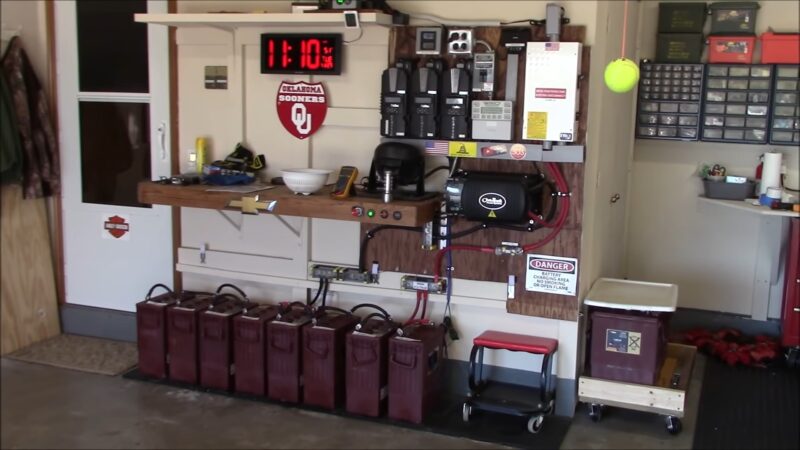
The better choice for your first bank of batteries is the Trojan L16. They have about 60% more capacity but cost more than double. The reason for the extra cost is they have far more lead and electrolyte than the T105, making them last a lot of lot longer.
Trojan’s L16s have a C20 rating of 370 AH (amp hours) at 6 volts. The usual price for a Trojan L16 is approximately $270-320 USD each. The price is typically closer to $270 when buying in bulk.
The L16 is a great battery for many solar systems as they are well made, have a decent amount of lead and electrolyte and they are a manageable size and weight for transporting. Although we highly recommend them for new off-gridders, we also recommend them for experienced solar homesteaders as well. They are what we are using for our main battery bank right now.
Here Are the Numbers for the Trojan L16 if You Were to Install One String in Your Battery Bank:
370 amp hours at 12 volts – providing 4.4 kWh at 100% discharge – 2 batteries in total
370 amp hours at 24 volts – providing 8.9 kWh at 100% discharge – 4 batteries in total
370 amp hours at 48 volts – providing 17.8 kWh at 100% discharge – 8 batteries in total
Here Are the Numbers for the Trojan L16 if You Were to Install Two Strings in Your Battery Bank:
740 amp hours at 12 volts – providing 8.9 kWh at 100% discharge – 4 batteries in total
740 amp hours at 24 volts – providing 17.8 kWh at 100% discharge – 8 batteries in total
740 amp hours at 48 volts – providing 35.5 kWh at 100% discharge – 16 batteries in total
A new set of Trojan L16s should last about 6-9 years if well taken care of. We have seen them used up to 12 years and as little as 4 years. Battery care is very important.
Surrette S460 350 Amp Hours at 6 Volts
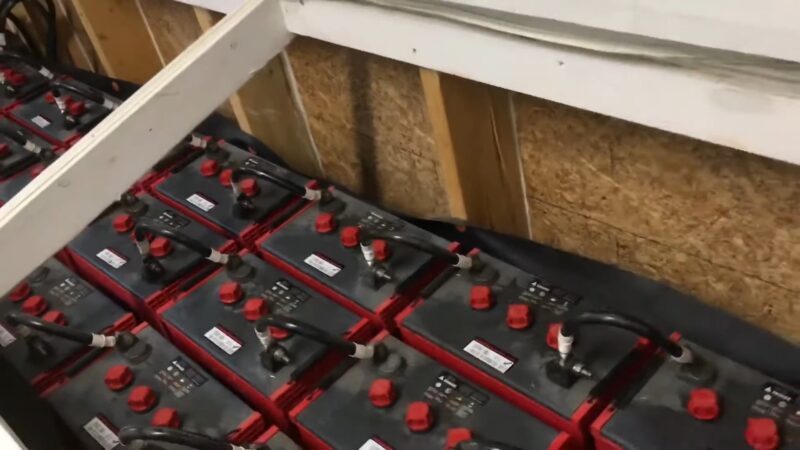
Another good choice for the solar newbie is the S460 by Surrette. You may have already assumed the S460 would be a 460 AH battery but it is not. Its C20 AH rating is 350. Its C100 rating is 460. What’s the difference?
Regardless of the misleading AH rating, the S460 is a well-built battery. They are made in Nova Scotia Canada and are usually of the best quality.
The usual price for a Surrette S460 is approximately $300-400 USD each.
They are made specifically for solar electric systems and were originally based on the L16.
Here Are the Numbers for the Surrette S460 if You Were to Install One String in Your Battery Bank:
350 amp hours at 12 volts – providing 4.2 kWh at 100% discharge – 2 batteries in total
350 amp hours at 24 volts – providing 8.4 kWh at 100% discharge – 4 batteries in total
350 amp hours at 48 volts – providing 16.8 kWh at 100% discharge – 8 batteries in total
Here Are the Numbers for the surrette S460 if You Were to Install Two Strings in Your Battery Bank:
700 amp hours at 12 volts – providing 8.4 kWh at 100% discharge – 4 batteries in total
700 amp hours at 24 volts – providing 16.8 kWh at 100% discharge – 8 batteries in total
700 amp hours at 48 volts – providing 33.6 kWh at 100% discharge – 16 batteries in total
Surrette S530 400 Amp Hours at 6 Volts
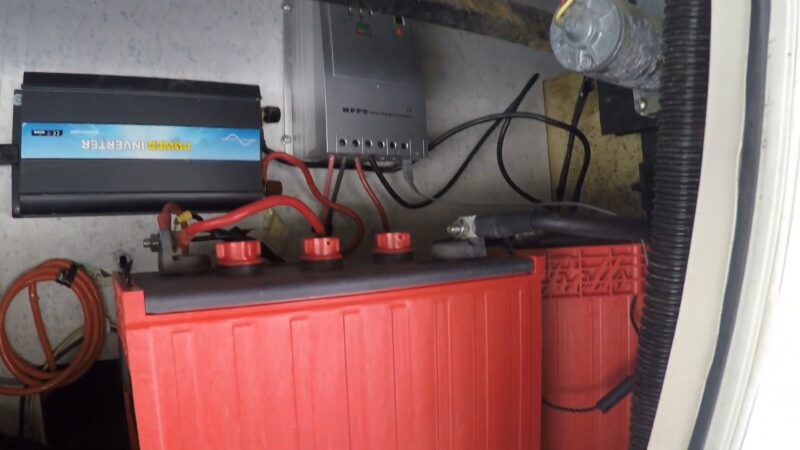
The Surrette S530 looks exactly like the S460 but it does contain more lead and more capacity. As it is in the same container as the S460 the extra lead means less room for electrolyte. Some would argue that adding more lead and less electrolyte could be a problem but it should be mentioned that Surrette increased the size of the battery’s case a few years ago when they added a new model…the S600. It even has more lead but right now we are talking about the S530.
The S530 is a well-built 400 amp hour 6-volt battery. They are made in Nova Scotia Canada and are a high-quality battery.
The usual price for a Surrette S530 is approximately $350-450 USD each. They are made specifically for solar electric systems and were originally based on the L16. They started with the basic shape and size of an L16 but made it bigger and stronger using thicker lead plates. If you can get a good price when buying the S530, they are a good choice as well for the solar first-timer.
Here Are the Numbers for the Surrette S530 if You Were to Install One String in Your Battery Bank:
400 amp hours at 12 volts – providing 4.8 kWh at 100% discharge – 2 batteries in total
400 amp hours at 24 volts – providing 9.6 kWh at 100% discharge – 4 batteries in total
400 amp hours at 48 volts – providing 19.2 kWh at 100% discharge – 8 batteries in total
Here Are the Numbers for the surrette S530 if You Were to Install Two Strings in Your Battery Bank:
800 amp hours at 12 volts – providing 9.6 kWh at 100% discharge – 4 batteries in total
800 amp hours at 24 volts – providing 19.2 kWh at 100% discharge – 8 batteries in total
800 amp hours at 48 volts – providing 38.4 kWh at 100% discharge – 16 batteries in total
- When buying your first set of batteries it can be intimidating, to say the least. There are so many choices. Many times the decision will be made for you as you might only be able to get one brand of batteries in your location.
- Trojan will likely be available and cost-effective in your area as they are one of the biggest solar battery suppliers on earth. If you want Surrette S530s but find out that you will have to pay much more for them compared to a Trojan or other brand L16, the non-Surrette is the better choice.
- Another consideration is availability and lead times for warranty issues. As nice as Surrette batteries are, they are rarely readily available. When we operated a solar store, it was not uncommon to have a six to nine-month lead time when buying directly from Surrette. We were not a small battery dealer either. We regularly bought pallets and pallets of batteries. Prepaying for 6 pallets of S460s and waiting for nine months is a very hard way to do business.
If you will have to wait a few months for your battery bank, what will happen if there is a warranty issue?
Are You Prepared to Wait Three to Six Months to Get a Replacement for Your Defective Battery?
If not, you better buy what the local battery supplier keeps in stock.
What About Other Brands of Golf Cart Battery or L16s?
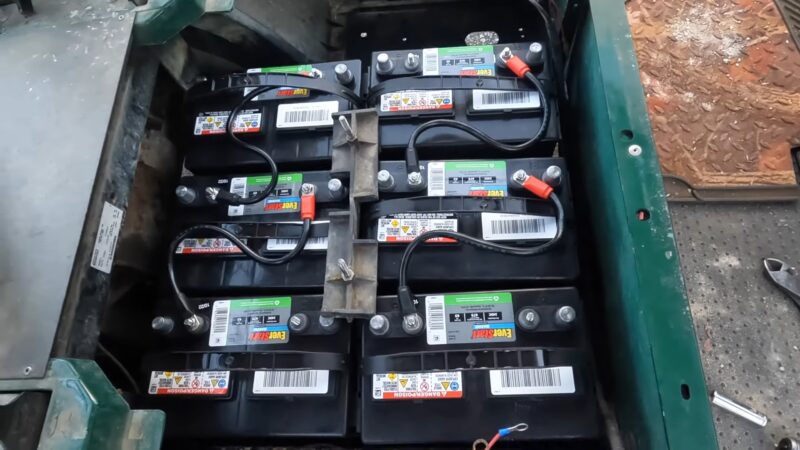
While Trojan is responsible for putting the golf cart battery and the L16 in the spotlight, there are hundreds of other battery manufacturers that make good-quality batteries. Some decent names are US Battery, Interstate, Energizer, Deka, Centennial, Universal, and Exide. Most golf cart batteries are of reasonable quality. When looking at other brands of golf cart batteries make sure they are 220-230 AH 6-volt batteries and weigh between 60 and 70 pounds. There are lower amp hour golf cart batteries out there that will not provide the capacity you are looking for.
The L16 is a little more complicated to compare. There are many shapes and sizes of L16. They can vary from 200 AH to 400 AH. If you are purchasing some L16s make sure they are in the range of 320 to 400 AH and they weigh approximately 100 to 125 pounds. Most folks don’t realize that even Trojan has many models of L16 that vary from 370 to 435 AH (C20) and weigh between 100 and 125 lbs.
If you can find a golf cart or L16 battery that is made by a known battery manufacturer, and they are readily available and affordable, they are probably a good choice. The importance of having a readily available battery cannot be understated. If you have a problem with one or more of your batteries, you will not be able to wait months for a replacement.
Why Are You Only Recommending Batteries Flooded Lead Acid (FLA) Batteries?
For your first, (and probably all) battery banks, flooded lead-acid batteries are the best option. Sealed batteries also known as AGM batteries are not very forgiving. Any battery that is sealed cannot be “brought back to life” if you cause any damage by undercharging or overcharging.
With an FLA battery, if you discharge the battery too much and cause a build-up of sulfate, you can bring it back to life with an equalization charge. Equalization is purposely overcharging the battery to remove sulfate and mix the electrolyte. However, water will escape and need to be returned. It is easy to add water to an FLA battery but a sealed battery is sealed and cannot take water. If you overcharge a sealed battery by mistake (or on purpose), any water that escapes cannot be returned. Learn more about equalization and battery maintenance.
Sealed batteries have their application but they are not usually a good option for the off-the-grid homestead.
What About Used Batteries?
This is a request we hear on a daily. Someone knows a guy who can get batteries from a phone or electric company that are being replaced due to regular maintenance. As the story goes, the batteries are like new and just need a new home. This is rarely a good idea.
Phone and electric companies are not stupid. They do not spend money on new batteries because it is fun. They spend money on new batteries as they know the old batteries are worn out. And 99% of the time they are worn out. I hate to see folks spend their hard-earned money on junk. Most of the time these companies are thrilled to see you come along with your money and your truck.
Discarding batteries is very expensive. You assume that responsibility when you take the used batteries away. Please do not ever buy used batteries. If they are free and you can transport them for free, then it might be OK. Other than that situation, do not waste your time with used batteries.
I Can Get a Whole Bunch of 12-Volt Car Batteries for a Good Price. Will They Work?
Not. Car batteries or starting batteries are not suitable for deep-cycle applications. Batteries that are made to start a car engine are made with a lot of very thin plates (to provide a lot of surface area) that provide good surge power, but they will not work as a deep cycle battery. The plates are paper thin.
The average car starting battery is good for about 10 cycles. If you leave your headlights on and drain your battery more than 5 or 10 times, it will be destroyed. The plates will either get hot and warp or be eroded and end up sitting on the bottom of the battery. Deep cycle batteries use thick plates made to handle deep cycles.
What About 12-Volt Deep-Cycle Batteries?
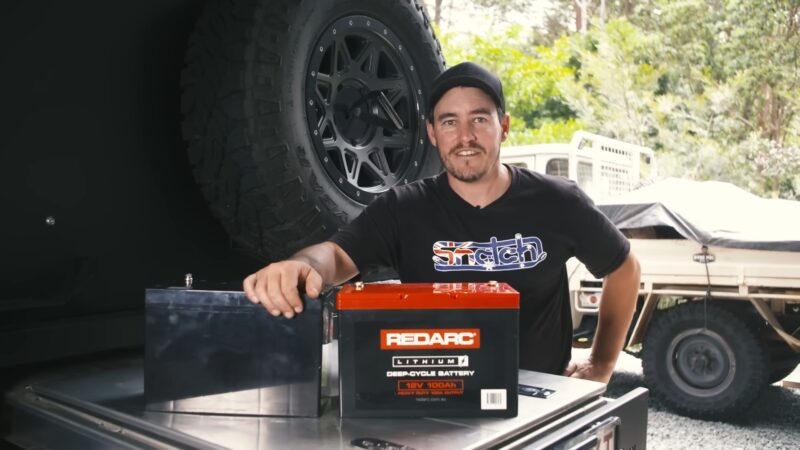
Unfortunately, 12-volt “deep cycle”/”marine” batteries do not make sense for the majority of off-grid applications. If you imagine a 6-volt golf cart battery, it is composed of 3 – two-volt cells that are wired in series to make six volts. There is just enough space to make fairly thick lead plates and fit them in the battery case. Now try and fit 6 – two-volt cells in the same size container as in the average “deep cycle” 12-volt battery. There is simply not enough space to do it right.
As a general rule the lower the battery voltage, the better the battery will be for deep cycling. The truth is most 12-volt so-called “deep cycle” batteries are not deep cycles at all. They are just starting batteries with plates that are a little bit thicker. The term “marine battery” also refers to a starting battery that has plates that are slightly thicker than a starting battery.
The only time we would recommend 12-volt batteries would be for a tiny system that you do not have to rely on. Maybe you have a cottage and you only want a small system to operate a few LEDs and a radio. In this case, a 12-volt deep-cycle battery would probably be fine. Another 12-volt battery application would be a solar traffic light or sign light. While a real deep cycle 2, 4, or 6-volt battery would perform much better, an inexpensive 12-volt unit might be OK for small systems.
Final Words
Starting your off-grid journey can be a thrilling yet challenging experience, especially when it comes to managing your energy systems. The key to a successful off-grid lifestyle is learning from your mistakes and making informed decisions. When it comes to choosing your first battery bank, consider options that offer a balance of cost-effectiveness and performance.
The Trojan T105, Trojan L16, Surrette S460, and Surrette S530 are all excellent choices for beginners. Remember, it’s not about buying the most expensive battery bank, but rather about understanding your energy needs and choosing a battery bank that can meet those needs efficiently and effectively. As you gain more experience living off the grid, you’ll be better equipped to invest in higher-quality battery banks and manage your energy systems more effectively.

